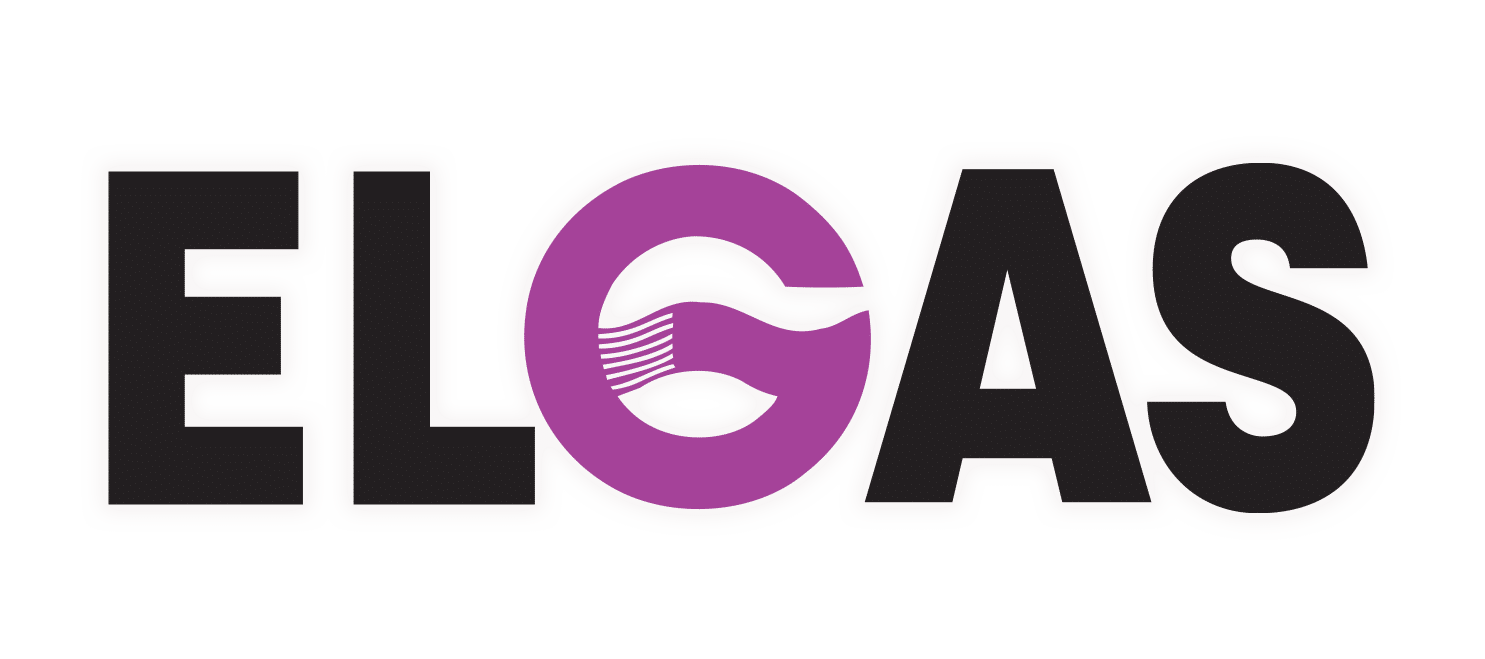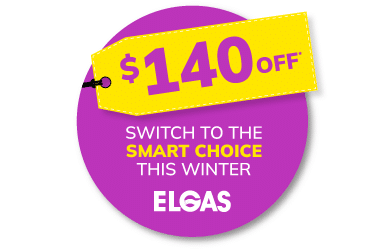How to Check Gas Bottle Level: Gas Bottle Level Indicator – Gas Bottle Gauge
How to check gas bottle level?
To check the gas bottle level, you can use the “hot water method” or “hot water test”: pouring a bucket of warm (not boiling) water down the side of the gas bottle, then feel for the temperature change, where it feels cold is the gas level.
How to check gas bottle level is by temperature with hot water, referred to as the hot water gas bottle test.
Remember safety first and do not use scalding hot water, just very warm water.
For the hot water gas bottle test, you pour a bucket of hot water down the gas bottle side and slide your hand down the side until it feels cold.
Pour slowly so as much of the water makes contact with the gas bottle as possible.
To locate the gas level, the point where the temperature changes is your gas bottle level indicator for the gas bottle or gas bottle gauge.
This how to check gas bottle level (test gas bottle level) works even better while using gas.
That’s a summary of how to check gas bottle level (test gas bottle level). You can also use a gas bottle gauge for the gas level indicator for gas bottles.
So, how to check gas bottle level (test gas bottle level) of remaining gas, in a gas bottle, is an easy process. For more detailed instructions, keep reading.
Also, to help it make sense we’ll explain how LPG works.
Gas Bottle Gauge for Pressure is NOT How to Check Gas Bottle Level
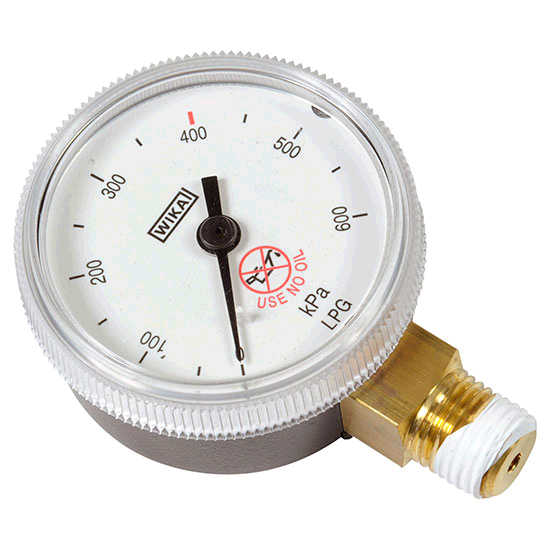 It‘s worth noting that a pressure gas bottle gauge isn’t how to check gas bottle level (test gas bottle level) or tell you how much gas is left in an LPG gas bottle.
It‘s worth noting that a pressure gas bottle gauge isn’t how to check gas bottle level (test gas bottle level) or tell you how much gas is left in an LPG gas bottle.
This is because LPG isn‘t compressed gas – it is a liquefied gas.
With LPG, the pressure inside your cylinder remains the same until the last of the liquid LPG is vaporised.
The gas bottle gauge will only move when you hit empty.
However, there is a different kind of gas bottle gauge that does work to check gas bottle level (test gas bottle level), to be discussed later.
How to Check Gas Bottle Level Instructions – Gas Bottle Level Indicator
The following are instructions on how to check gas bottle level (test gas bottle level):
This process of how to check gas bottle level (test gas bottle level) works for both large LPG gas bottles and BBQ size bottles, too.
The gas bottle level indicator can appear in one of two ways, being your gas bottle gauge, as explained below.
Here’s how to check gas bottle level (test gas bottle level) using condensation and/or temperature change as your gas bottle gauge (gas bottle level indicator):
- Fill a bucket with hot tap water. More water is better for how to check gas bottle level (test gas bottle level).
- Slowly pour the hot water (not boiling water) down one side of the gas bottle. (Take care not to scald yourself)
- A line of condensation may appear as the gas bottle level indicator (gas bottle gauge). If not:
- Wait a few seconds and then run your hand down the same side of the gas bottle, where you poured the water.
- You should feel a noticeable cooler change of temperature at the level of the gas. The point where the temperature changes is another gas bottle level indicator (gas bottle gauge) for gas bottles.
- If you feel no difference when you check gas bottle level (test gas bottle level), it may be empty.
PRO TIP: The hot water test to check gas bottle level (test gas bottle level) works even better during or after you use one of your LPG appliances, making the finding of the gas bottle level indicator for gas bottles even easier.
For example, if you have LPG hot water, look for the gas bottle level indicator (gas bottle gauge) during or right after someone takes a shower. The condensation gas bottle level indicator (gas bottle gauge) may even appear without pouring the bucket of hot water.
Watch a quick video on How to Check Gas Bottle Level (test gas bottle level)
Gas Bottle Level Indicator (gas bottle gauge) for Gas Bottles that are Empty
There is no gas bottle level indicator (gas bottle gauge) for gas bottles that are empty.
How to check gas bottle level for empty is a process of elimination.
When you look for the gas bottle level indicator with the hot water test, you may not see a condensation line, as your gas bottle level indicator (gas bottle gauge), nor feel any difference in temperature.
This is your gas bottle level indicator for gas bottles that are empty, as you have not detected either of the two gas bottle level indicator for gas bottles.
Why Does the Gas Bottle Feel Cold as Gas Bottle Level Indicator? Gas Bottle Gauge
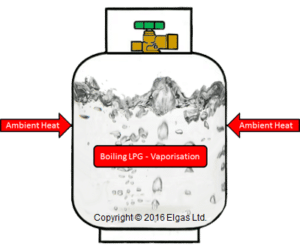 The nature of LPG provides the gas bottle level indicator or gas bottle gauge.
The nature of LPG provides the gas bottle level indicator or gas bottle gauge.
LPG (propane) is stored under pressure as a liquid in a gas bottle.
It turns back into a gas by ‘boiling’.
LPG draws heat from the steel walls of the gas bottle. (see image)
This ‘boiling’ LPG makes the gas bottle feel colder when you check gas bottle level (test gas bottle level) at the level where there is remaining liquid gas.
That’s why it is the gas bottle level indicator, with condensation or temperature change as your gas bottle gauge.
When gas escapes the bottle rapidly, ice can even form on the gas bottle exterior, providing the perfect visual gas bottle gauge.
How Full is Full? Gas Bottle Level Indicator at 80%
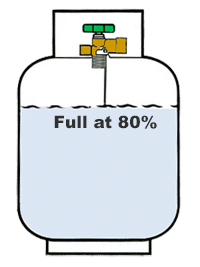 Also, please remember that gas bottles are designed to be full at 80% or just over 3/4. So, your gas bottle level indicator (gas bottle gauge) will be at 80% when full.
Also, please remember that gas bottles are designed to be full at 80% or just over 3/4. So, your gas bottle level indicator (gas bottle gauge) will be at 80% when full.
This allows for the natural expansion of the gas during warmer temperatures.
For safety reasons, NEVER open the valve on an unattached gas bottle for how to check gas bottle level (test gas bottle level) for remaining gas, even if you think it is empty.
Check gas bottle level (test gas bottle level) regularly so you stay on top of your usage for your cooktop and gas heaters and always know when it’s time to check gas bottle level (test gas bottle level) and re-order.
8 Tips for Never Running Out of LPG Gas Again!
1. Check gas bottle level (test gas bottle level) regularly. Always order gas as soon as the first bottle runs out.
Don’t wait until the gas bottles are both empty or near empty.
Follow this advice and you are virtually assured to never run out of gas.
 2. Remember to order sooner, rather than later, during the busy winter season.
2. Remember to order sooner, rather than later, during the busy winter season.
3. Remember to check gas bottle level (test gas bottle level) more often in cold weather, especially if you use a gas heater or gas log fire.
Even your water heater has to work harder in cold weather, as the incoming water is colder.
4. Having additional house guests can also increase your usage if you have gas hot water.
Remember to check gas bottle level (test gas bottle level) more often so both you and your guests avoid cold showers!
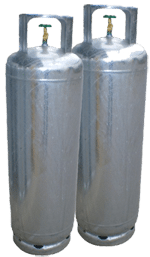 5. If you only have one gas bottle attached to your home, you may wish to consider adding a second gas bottle.
5. If you only have one gas bottle attached to your home, you may wish to consider adding a second gas bottle.
Unless you are on automatic tanker delivery, you will either run out or have to call for a gas bottle exchange before using up all of your gas.
These are both situations you would surely like to avoid.
A second bottle solves the problem and is particularly wise if you use your gas for hot water and/or heating.
6. If you are an ELGAS customer, make sure we have your Mobile Number so you receive Gas Check Alerts™ by Text (SMS) to remind you to check gas bottle level (test gas bottle level).
These are sent automatically, by our computer, based on your past gas usage.
With Gas Check Alerts, you will never forget to check gas bottle level (test gas bottle level) again.
7. Remember to increase how often you check gas bottle level (test gas bottle level) if you install additional gas appliances.
8. Also, be certain to tell your supplier if you install additional appliances, especially if you are on automatic tanker delivery, so we can adjust your delivery schedule.
Follow these tips and you should enjoy using of your gas appliances without interruption.
Get $140 in LPG Account Credits!
Choice of 2-Year Fixed or Variable 45kg Gas Bottle Price
No Lock-in Contracts
We return your old gas bottles for you
It is a great time to switch to ELGAS
Other Methods to Check Gas Bottle Level
Ultrasonic Gas Bottle Gauge
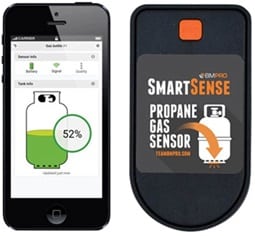 One type of gas bottle gauge is an ultrasonic unit that sits under the BBQ gas bottle and is how to check a gas bottle level indicator via Bluetooth via a gas bottle gauge app on your mobile phone.
One type of gas bottle gauge is an ultrasonic unit that sits under the BBQ gas bottle and is how to check a gas bottle level indicator via Bluetooth via a gas bottle gauge app on your mobile phone.
Truma LevelCheck, SmartSense and Lippert Bottlecheck are amongst the brands, but there are many others.
SmartSense and Lippert Bottlecheck gas bottle gauge apps shows the gas bottle gauge – gas bottle level indicator on your mobile phone.
You buy the gas bottle gauge then download and install the gas bottle gauge app.
The Bluetooth gas bottle gauges work well on BBQ bottles but cannot be used with a 45kg gas bottle, but the Truma LevelCheck should help check gas bottle level on a 45kg.
For larger gas cylinders, can also stick with the hot water gas bottle test for your gas bottle level indicator.
Weigh the Bottle to Check Gas Bottle Level
An alternative way of how to check gas bottle level for BBQ gas bottles is to weigh the bottle by using a scale as your gas bottle gauge.
Turn off the gas regulator, disconnect the bottle and place it on a scale, making sure the valve is firmly closed.
The tare (empty) weight of the bottle is stamped on the neck ring.
The difference between the scale reading and the tare weight is the calculated gas bottle level indicator to tell you how much gas is left in the gas bottle.
Shake the Bottle
You can shake the gas bottle, if small enough to do so safely.
If you hear or feel gas movement, that means that some gas remains but you won’t know precisely how much.
Pressure Gauges Do NOT Check Gas Bottle Level for LPG
Pressure gauges do NOT provide an accurate way to check gas bottle level for LPG.
This is because the pressure in an LPG gas bottle remains constant from full until almost empty, as it is a liquefied gas, not a compressed gas.
So, save your money.
Summary of Gas Bottle Level Indicator and Gas Bottle Gauge Use
Now you know how to check gas bottle level (test gas bottle level) by looking for one of the two gas bottle level indicator signs: a condensation line or a change of temperature as your gas level indicator (gas bottle gauge) for gas bottles.
For how to check gas bottle level for a 9kg gas bottle, you can use an ultrasonic gas bottle gauge or use a scale to check gas bottle level.
So, check gas bottle level (test gas bottle level) regularly so you never run out of gas.
New Residential LPG customer?
New Business LPG customer?
Existing ELGAS customer?
- BBQ – Gas and Charcoal BBQ Features – Charcoal BBQ vs Gas BBQ Comparison - March 31, 2025
- GPL Gas (GPL Fuel) – GLP Gas – LPG Gasul: GLP – GPL Station Near Me - March 26, 2025
- Think LPG When Building a New Home - February 26, 2025
Steve Reynolds
Technical Consultant
Steve Reynolds is a leading expert in the LPG industry with over 22 years of experience. As part of the national management team at ELGAS, Steve ensures the safe and efficient storage, handling, and transportation of LPG. He serves as the lead investigator for incidents and collaborates with authorities on industry developments.
Steve is a technical advisor to Standards Australia and Gas Energy Australia (GEA), and an active member of the World LPG Association (WLPGA), contributing to global standards and technical reviews. He holds a BSc. (Hons) in Industrial Chemistry from UNSW and has held senior safety and technical roles at ELGAS, making him a trusted authority in LPG safety and standards.
